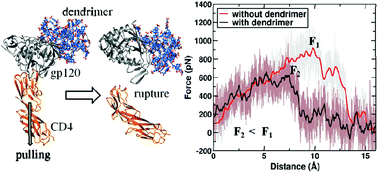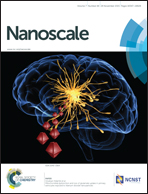The SPL7013 dendrimer destabilizes the HIV-1 gp120–CD4 complex†
Abstract
The poly (l-lysine)-based SPL7013 dendrimer with naphthalene disulphonate surface groups blocks the entry of HIV-1 into target cells and is in clinical trials for development as a topical microbicide. Its mechanism of action against R5 HIV-1, the HIV-1 variant implicated in transmission across individuals, remains poorly understood. Using docking and fully atomistic MD simulations, we find that SPL7013 binds tightly to R5 gp120 in the gp120–CD4 complex but weakly to gp120 alone. Further, the binding, although to multiple regions of gp120, does not occlude the CD4 binding site on gp120, suggesting that SPL7013 does not prevent the binding of R5 gp120 to CD4. Using MD simulations to compute binding energies of several docked structures, we find that SPL7013 binding to gp120 significantly weakens the gp120–CD4 complex. Finally, we use steered molecular dynamics (SMD) to study the kinetics of the dissociation of the gp120–CD4 complex in the absence of the dendrimer and with the dendrimer bound in each of the several stable configurations to gp120. We find that SPL7013 significantly lowers the force required to rupture the gp120–CD4 complex and accelerates its dissociation. Taken together, our findings suggest that SPL7013 compromises the stability of the R5 gp120–CD4 complex, potentially preventing the accrual of the requisite number of gp120–CD4 complexes across the virus–cell interface, thereby blocking virus entry.


 Please wait while we load your content...
Please wait while we load your content...